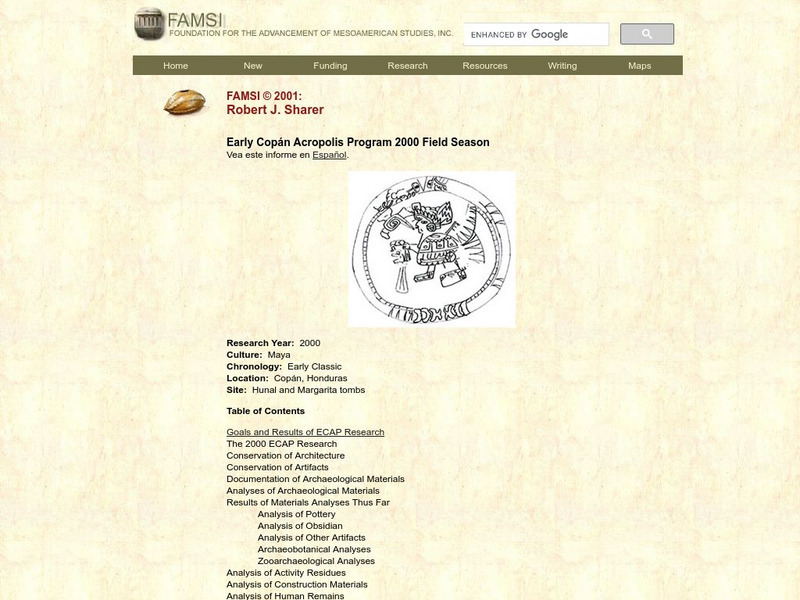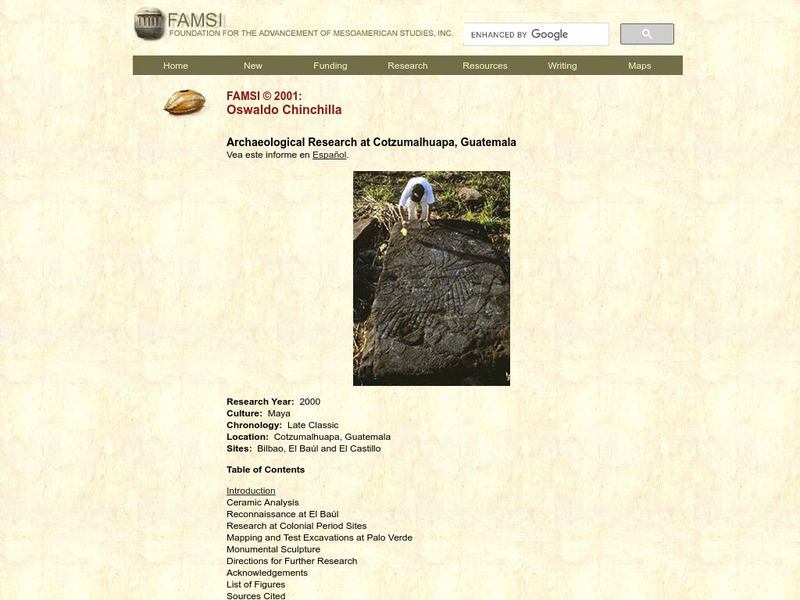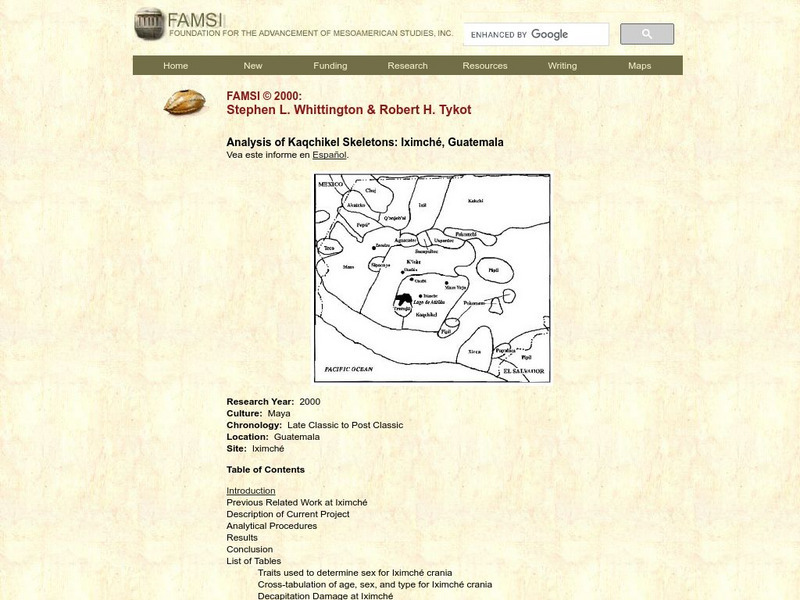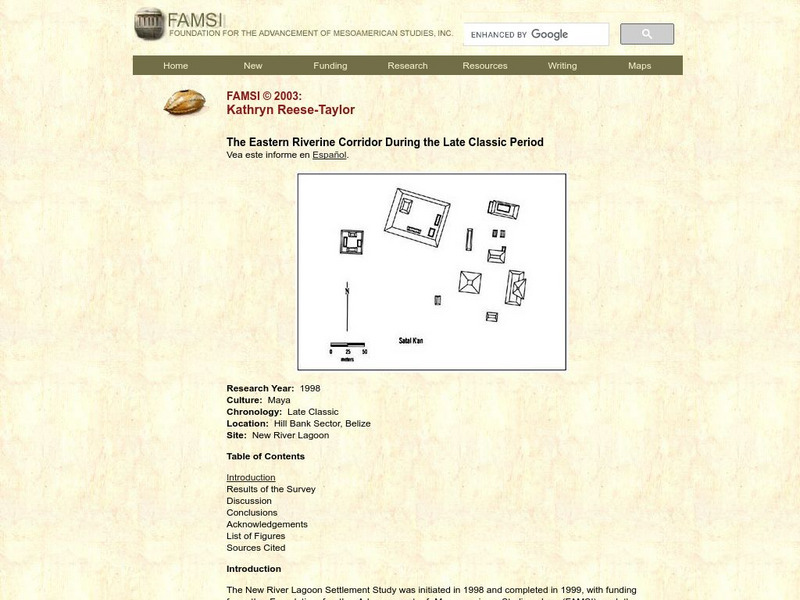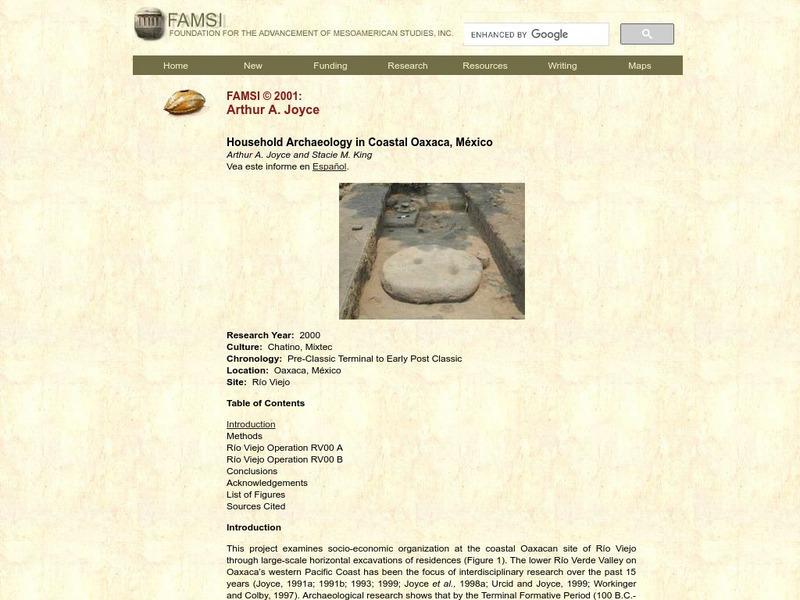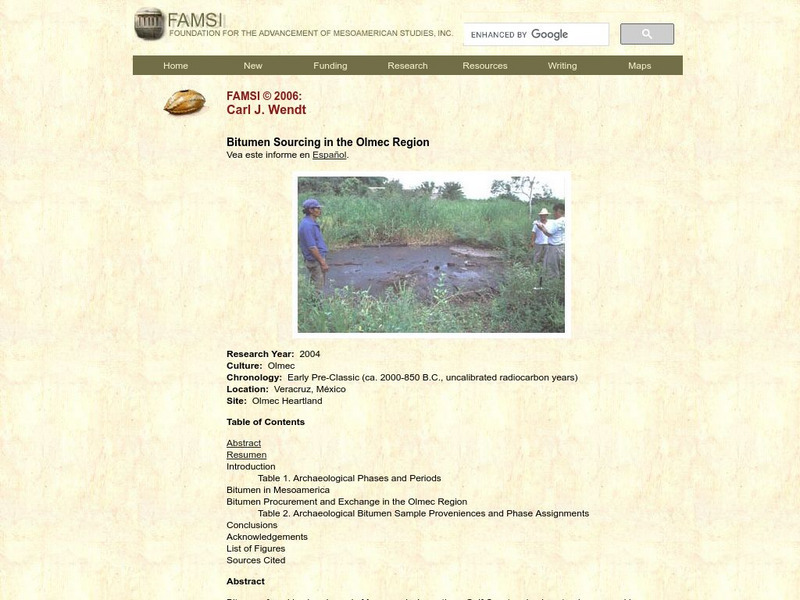Foundation for the Advancement of Mesoamerican Studies
Famsi: Early Copan Acropolis Program 2000 Field Season
Final report of archaeological data and conclusions of Mayan history at Hunal and Margarita tombs in Copan, Honduras. Information given on pottery, tools, agriculture, and fauna.
Foundation for the Advancement of Mesoamerican Studies
Famsi: Archaeological Research at Cotzumalhuapa, Guatemala
Research at Cotzumalhuapa indicates that it was a major urban center that encompassed Bilbao El Baul, and El Castillo. Some discussion of colonial period use of site.
Foundation for the Advancement of Mesoamerican Studies
Famsi: Soconusco Formative Project (2000)
Excavation at this site indicates no other occupation after Middle Formative period, a fact that will drive research in this area. Site includes photographs of artifacts as they are found.
Foundation for the Advancement of Mesoamerican Studies
Famsi: Salvage of Hieroglyphic Stairway in Dos Pilas (2002)
Comprehensive discussion of what the discovery of stairway steps adds to history of the site and the culture. Writings on steps give new insights to Myan politics, trade, war, and the collapse of the civilization.
Foundation for the Advancement of Mesoamerican Studies
Famsi: The Glyphic Corpus From Ek' Balam (2002)
Offers translations of hieroglyphs, and therefore history, of the Mayan dynasties and rulers at Ek' Balum in Yucatan, Mexico.
Foundation for the Advancement of Mesoamerican Studies
Famsi: Classic Maya Borders and Frontiers (2003)
A look at the geology and topography of El Paraiso valley and its influence on communication, passage and trade. Report also considers architecture and "Mayanization" of area.
Foundation for the Advancement of Mesoamerican Studies
Famsi: Investigating Tarascan State at Erongaricuaro, Mexico
Erongaricuaro site was compared to neighboring site of Uricho in the Tarascan State to determine social organization and social hierarchy. Copper is a marker of high status.
Foundation for the Advancement of Mesoamerican Studies
Famsi: Primary Standard Sequence (Of Mayan Hieroglyphs) 2003
PDF document that shows structure of Mayan glyphs and translation, including spelling patterns and syntax. Photographs and charts show how meaning is derived from hieroglyphic strip.
Foundation for the Advancement of Mesoamerican Studies
Famsi: Archaeological Investigations in the Homul Region (2003)
Several PDF reports offered at this site offer insights to the sequence of construction by various cultural groups. Very descriptive details of each step of the excavation process and photographs are provided.
Foundation for the Advancement of Mesoamerican Studies
Famsi: Analysis of Kaqchikel Skeletons: Iximche, Guatemala
Report of structural and chemical analysis of skeletal items offers insights into human sacrifice procedures and diet.
Foundation for the Advancement of Mesoamerican Studies
Famsi: The Jolja' Cave Project (2001)
Three caves containing pre-Columbian artifacts, murals, and hieroglyphs are documented in this report. Also of interest is commentary on the reports of modern Ch'ol Mayans with regard to ancient belief and current religious belief.
Foundation for the Advancement of Mesoamerican Studies
Famsi: 2001 Study of Labna Kiuic Archaeological Project
Goals of this study are to investigate reasons for the abandonment of the region, settlement patterns, and political organization of the Puuc region.
Foundation for the Advancement of Mesoamerican Studies
Famsi: La Laguna Transformations and Community Organization
Excavations and analysis of the location of various artifacts found at La Lugana indicate areas of specialization, social segregation, and religious integration.
Foundation for the Advancement of Mesoamerican Studies
Famsi: Excavation of Formative Cemeteries in Mascota Valley, Mx
Descriptive and pictorial detail of excavations at Los Coamajales and El Embocadero II in 2004 offering information on Capacha and El Pantano cultures.
Foundation for the Advancement of Mesoamerican Studies
Famsi: Economic Foundations of Mayapan Project (2001)
Although this excavation is still in progress, preliminary reports indicate occupants produced pottery for local and regional consumption. Also the production of tools and jewelry depended on materials from other parts of the region.
Foundation for the Advancement of Mesoamerican Studies
Famsi: Long and Winding Road (1000)
Progress report on the investigation of peninsular-wide road in Yucatan referred to as the Maya Causeway.
Foundation for the Advancement of Mesoamerican Studies
Famsi: Epi Classic Cultural Dynamics in the Mezquital Valley
Interesting study of artifacts used to demonstrate inter-regional trade in the Mezquital Valley area of Mexico during A.D. 600-1000. This work also offers good insights into specific cultures.
Foundation for the Advancement of Mesoamerican Studies
Famsi: Danzantes of Building L at Monte Alban
Excellent descriptions of Monte Alban and the Danzantes wall. Report specifies Olmec presence in area as well.
Foundation for the Advancement of Mesoamerican Studies
Famsi: Politics and Economics: Motul De San Jose, Peten
Excavations at Motul de San Jose indicate that the site was more populated than previously thought. Findings indicate that production of textiles, tools, and ceramics were carried out in this city-state.
Foundation for the Advancement of Mesoamerican Studies
Famsi: The Eastern Riverine Corridor During Late Classic Period
Inventories of ceramic materials and architectural similarities indicate that some urban centers may be socially and politically connected while others are not. Study confirms a water route from New River drainage area to Belize may have...
Foundation for the Advancement of Mesoamerican Studies
Famsi: Nature of Governance in Secondary (Mixtec) Centers
Pottery, ceramic materials, and architecture were examined to provide insights on political affiliations of Mixtex cities in Mexico.
Foundation for the Advancement of Mesoamerican Studies
Famsi: Household Archaeology in Coastal Oaxaca, Mexico
Offers dimensions of Mixtec household and density of urban village. Household ritual included food processing, tool and textile production, and ceramic production using molds. The importance of Rio Viejo as an urban center is discussed.
Foundation for the Advancement of Mesoamerican Studies
Famsi: Bitumen Sourcing in the Olmec Region (2004)
Study suggests that chemical studies on bitumen (hydrocarbon material) is a feasible method of studying inter-regional trade and social networks. Includes a chart defining archaeological phases of the Olmec Culture.
Foundation for the Advancement of Mesoamerican Studies
Famsi: Palenque Hydro Archaeology Project (2005)
Study indicates that Palenque aquaducts were part of city planning and suggests reasons that Mayans would choose the existing plan. Many photographs of the aquaduct are included.


